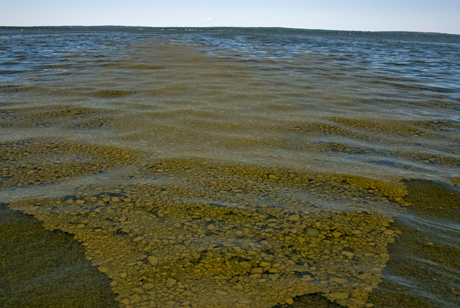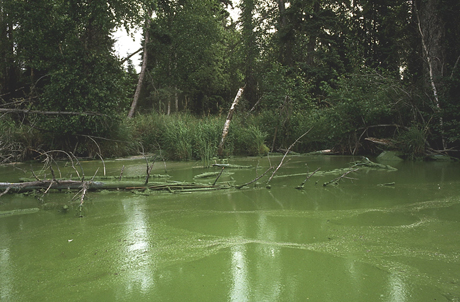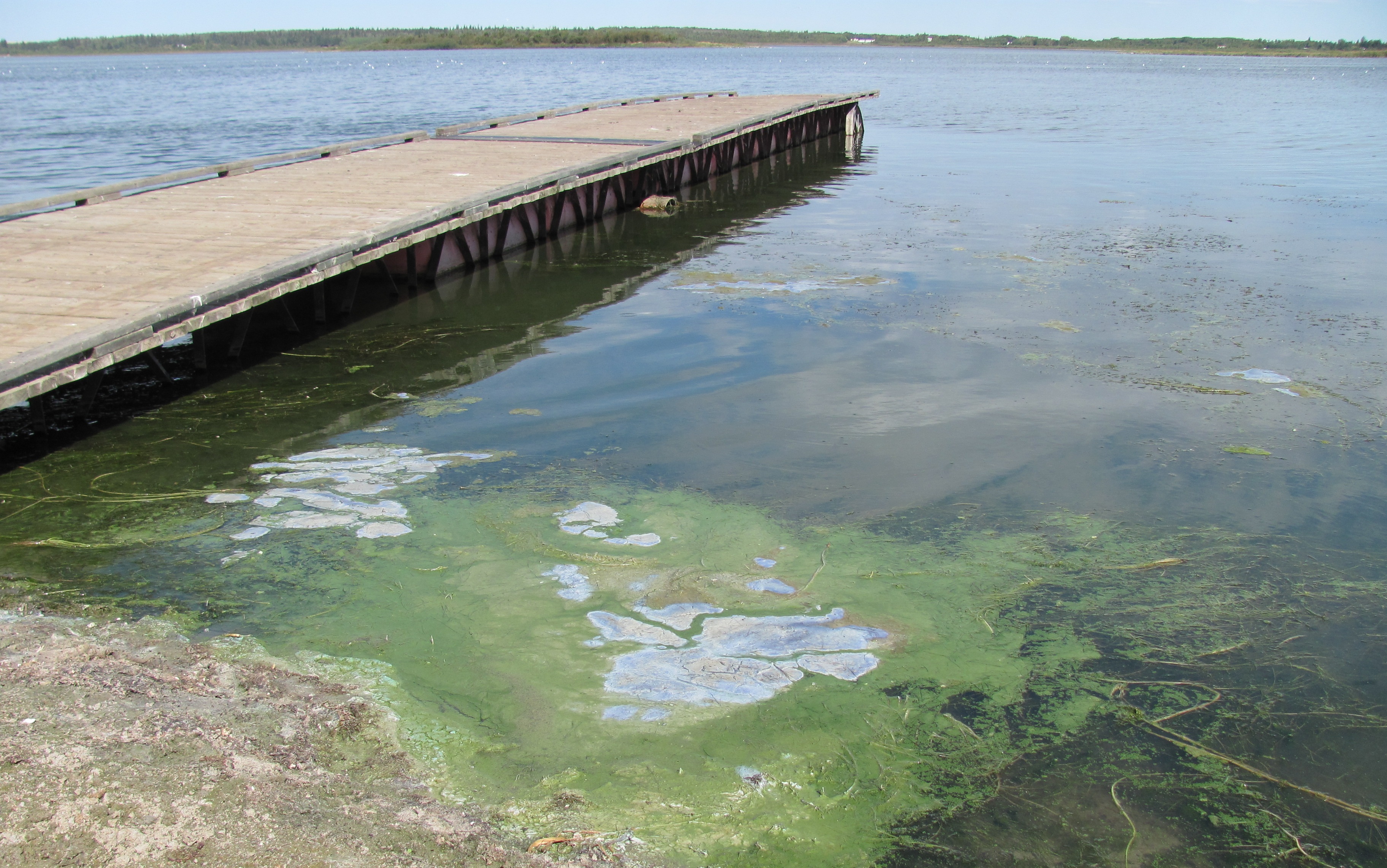What are cyanobacteria?

Large growth (bloom) of cyanobacteria on a lake.
Source: Ron Zurawell, Alberta Environment
Cyanobacteria (also called blue-green algae) are types of bacteria found in many lakes, ponds, and other bodies of water. Many types of cyanobacteria can control whether or not they float (buoyancy), which lets them to move up and down in the water.
Cyanobacteria can multiply a lot in the summer, which causes large growths called blooms. Cyanobacteria blooms can be blue-green, greenish-brown, or pinkish-red and can smell musty or grassy. Blooms often look like scum, streaks, or mats on the water surface or throughout the water. Cyanobacteria blooms often form when conditions are calm.

Cyanobacteria bloom on a lake.
Source: Ron Zurawell, Alberta Environment
How do cyanobacteria blooms affect human health?
Some types of cyanobacteria that form blooms also produce toxins that can affect your health. Most toxins break down within days, but they can stay in the water at low levels for weeks after a bloom disappears.
Some blooms don't contain toxins, but you can't tell if a bloom is harmful or not from how it looks. If you see a bloom, assume it is toxic and take precautions.

Cyanobacteria bloom at the shore of a lake.
Source: Environmental Public Health, Alberta Health Services
Children might be more at risk for getting sick from cyanobacteria because they often spend more time in the water and may swallow contaminated water by accident.
If you have
contact (like swimming) with water that has a cyanobacteria bloom, it can cause:
- skin irritation and rash
- sore throat
- sore, red eyes
- swelling of your lips
- hay fever symptoms, like stuffy nose
If you
drink water with cyanobacteria, it can cause:
- headache
- diarrhea
- weakness
- liver damage
- fever (temperature over 38.5°C or 101.3°F)
- nausea and vomiting
- muscle and joint pain
- cramps in your abdomen (belly)
Treat all cyanobacteria blooms with caution. Call Health Link at 811 if you drink or have been in contact with water that has a cyanobacteria bloom and are having symptoms.
How do cyanobacteria blooms affect livestock and pets?
Some illnesses and deaths of livestock, pets, and wildlife have been linked to animals drinking water containing toxins from cyanobacteria blooms. Keep animals away from water sources with cyanobacteria blooms because animals aren’t concerned with how water looks or smells before they drink it.
Don’t let animals eat whole fish or trimmings (any waste from cutting up a fish, including the head, bones, intestines, or skin) from affected lakes.
Can I water my vegetable garden with lake water that has a cyanobacteria bloom?
Don’t use water sources with cyanobacteria blooms to water plants you can eat. Toxins from cyanobacteria can contaminate fruits and vegetables, including lettuce, carrots, and tomatoes.
Is it safe to cook with water from a water source with a cyanobacteria bloom?
No. Don’t cook with water that might have a cyanobacteria bloom. Boiling water doesn’t remove cyanobacteria toxins.
Is it safe to eat fish from water with a cyanobacteria bloom?
You can safely eat fish fillets (boneless pieces of fish meat) from lakes with a cyanobacteria bloom. You might want to limit how much whole fish and trimmings (any waste from cutting up a fish, including head, bones, intestines, or skin) you eat, because fish store toxins in their livers.
What can I do to help prevent cyanobacteria blooms?
The best way to help prevent cyanobacteria blooms is good watershed management. Watershed management means thinking about the interaction of land, water, plants, animals, and people across many areas that are connected by water. Watershed management looks at the impact of a variety of land uses on water.
You can help control cyanobacteria blooms by limiting the nutrients that go into water systems, like from wastewater or runoff from agriculture. You can limit nutrients by not using lawn fertilizers and by properly maintaining your private sewage systems.
What else do I need to think about?
Treat any cyanobacteria bloom as if it is contaminated with toxins.
- Don’t swim or wade in water with scum on the surface.
- Don’t drink water if it might have cyanobacteria.
- Have another source of drinking water for pets and livestock.
- If you see a bloom, call Environmental Public Health at 1-833-476-4743 or
report it online.
- Call Health Link at 811 if you drink or have been in contact with contaminated water and have any symptoms.
- Call a veterinarian if your pet drinks or has been in contact with contaminated water.
If you have any questions, contact
Environmental Public Health.
